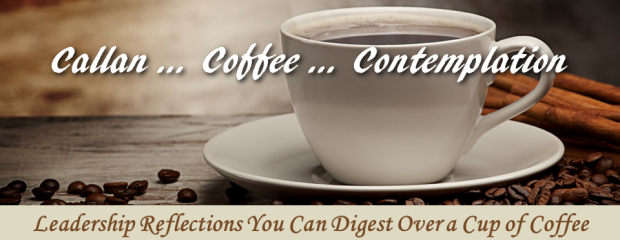Callan…Coffee…Contemplation for the Week of June 30th
Gratitude
I was recently asked, “what gives you energy during each day?” This question wasn’t focusing on occasional inspiration, but day-to-day vitality. The answer I kept coming back to was this: Gratitude. Sounds strange because we usually think we have to be the receiver of something to feel energized, and with gratitude, we are actually giving something away. When I contemplate my leadership experiences—sports, the Marine Corps, volunteering, Corporate—what I see as the great energizer of my daily leadership was actually giving more than getting. And when good things were accomplished by others in support of common goals, showing genuine gratitude to those whose efforts carried the day was actually energizing to me. Being grateful is not soft leadership, it is iron leadership; it requires each of us to be aware of other’s contributions and service and then—having the self-awareness and self-control to personally acknowledge it. It may seem counterintuitive, but to keep one’s leadership battery charged daily, look to give, not get. Show gratitude and bring vitality to the receiver and to yourself.
Building Bridges
Today, more than any other point in our history, there are more generational groups coupled in the workforce. For example, one might see members from the Korean War Generation, Baby Boomers, Gen X and Gen Y inhabiting the halls of a single company. This fact brings increasing criticality for the production of wise elders—or bridge builders—in our groups. Like successive waves of climbers ascending a mountain, our society needs our wisest and most experienced members to serve as Sherpas–trusted guides who can describe the journey, navigate the terrain, help during slips and falls, and keep the group pointed toward the summit. Too often, though, older leaders are encouraged to focus only on their own career paths and their own retirement plans. As such, they reach the summit for themselves but do not return to base camp to help others make the climb. This is not a model for enduring excellence. Instead, we must rekindle our value of, and expectation for, the production and retention of wise elders, and then set them loose to serve as bridge builders between generations.
The Spinning Wheel
If we are honest about our development as leaders, we see a circular or spiral pattern to our growth and development. Our path is neither easy, direct, nor predictable, nor is it a consistently upward trajectory. I equate a leader’s true growth to a spinning wheel; at times we are on the right path, at others, we forget and fall off the path. At times we are on a purposeful quest, at others, we are adrift. At times we are elevated by higher meaning, at others, we are mired in the drudgery of daily details. This spinning wheel is a reminder that great leadership and heroic ambition are difficult and require constant fidelity and self discipline. It seems to me leaders often cycle back-and-forth between remembering our purpose and then forgetting. This is the cycle of the wheel: Remembering and forgetting, loss and renewal. But what is most illuminating, when we realize this circular reality, is this: The spinning wheel is really our teacher. The spiral nature of our leadership path is actually guiding us to go to the places we usually avoid but most need to go, and towards the experiences and lessons we most need to learn.
Seven Generations
I have long admired the traditions of Native American culture. Their warrior ethos had much in common with my chosen profession and my vocation as a US Marine. In particular, I admire a legend concerning Iroquois elders. It is said they would assemble as a council to decide on matters of great importance, and when they did, they would make decisions not just for today but “for the good of the next seven generations.” What’s the lesson for us? First, in the first half of life we are drawn to climbing our own ladders and gaining personal credentials. However, to become great leaders we must cross over in the second phase of life to giving back, and giving away, what we have reaped. Second, we should cultivate wise elders within our groups and then place these elders in a position to guide, shepherd, and mentor emerging generations. Finally, when we work for the next generations, we create a culture and atmosphere that shuns instant gratification and small private worlds and instead opens us to larger and more elevating ambitions. This is true heroic energy.
Warrior Spirit
I recently read a book about Ignatius of Loyola and the Jesuits. What struck me about Loyola and his remarkable companions was their heroic ambition and their healthy warrior spirit. A true understanding of warrior spirit is akin to positive energy, ambition, and aspiration directed toward larger purposes and elevated meaning. Warrior spirit is like a mythic Knight’s quest–a person devoting oneself to greater good, willing to transform to gain self mastery. This is the true meaning of warrior spirit; to be on fire for a vocation, a calling, and a commitment to something larger than self. I was drawn to and remained soulfully bound to the US Marine Corps for nearly 30 years due mainly to its ethos built around this classic understanding of a warrior ethic and warrior energy. So what is the lesson for us all? It is this: People will always value being taught about healthy boundaries, traditions, discipline, respect, dignity, and sacrifice if linked to a healthy warrior spirit because it elevates us towards, and binds us in, common purposes and a larger view of life and leading.
Check back next Monday for a round up of this week’s social media shares. Or check us out on Facebook,Twitter, Google+, or Pinterest to see our posts every day!
Tweet Share






